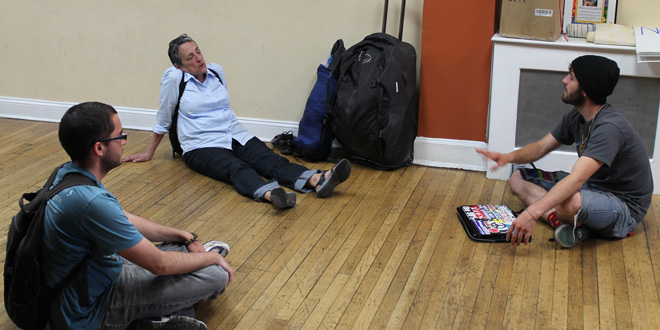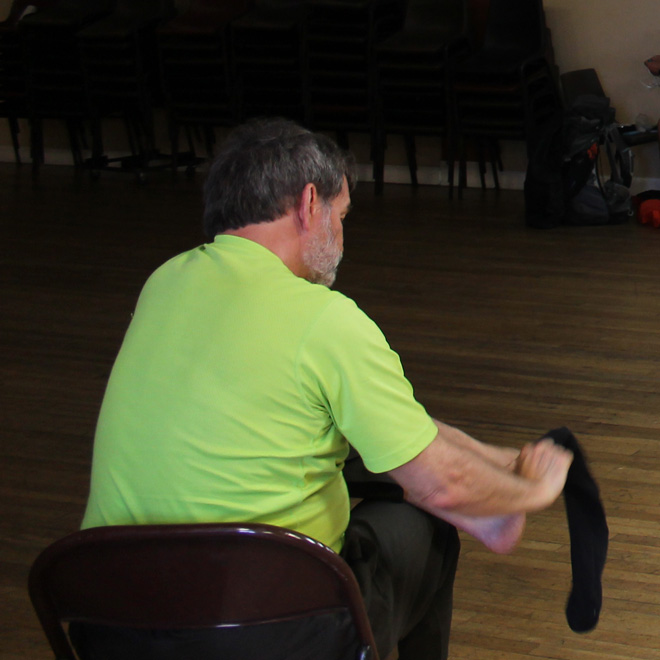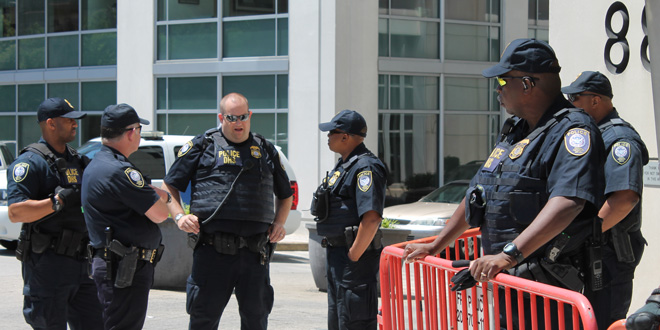By Michael Brooks
WASHINGTON — It’s Friday afternoon at St. Stephen and the Incarnation Episcopal Church in the Columbia Heights neighborhood in D.C. and, to anyone who’s attended a Federal Energy Regulatory Commission open meeting over the past year, there are a few familiar faces.
There’s Ted Glick, national campaign coordinator for Chesapeake Climate Action Network, who was among the first to test FERC’s new rules regarding disruptive behavior in March — as well as the first protester to speak at Norman Bay’s first meeting as the commission’s chair in April.
There’s Jimmy Betts, who started a chain of interruptions at FERC’s meeting in January, leading then-Chairman Cheryl LaFleur to call a recess while security cleared the floor of protesters.
And there’s Lee Stewart, who was carried out of April’s meeting by security.
But there are more unfamiliar faces, some of them FERC is seeing for the first time.
They all have taken up temporary residence at the church for a week’s worth of protest activities: marches, workshops, training and, of course, rallying outside of FERC headquarters. It is a somewhat homogenous group, mostly from the Northeast U.S., but with a variety of concerns, ranging from climate change to eminent domain to hydraulic fracturing’s effects on the environment. But all of them agree: FERC is a rogue agency that is beholden to the natural gas industry, insulated from public scrutiny and unconcerned with the long-term effects of fossil fuels on the planet’s climate.
Beyond Extreme Energy
Called “Stop the FERCus,” the events scheduled through May 30 were planned months ago. They were intended to begin on Thursday to coincide with this month’s FERC meeting. But the commission rescheduled it a week earlier in an effort to avoid any major disruptions. Instead, there were only minor ones. (See Another Meeting Day, Another Drama at FERC.)
The protests against FERC are often attributed to a single group, called Beyond Extreme Energy. Glick calls BXE a “coalition” of about 70 groups, mostly local alliances created to stop individual pipeline projects.
BXE’s mission now is to fundamentally change FERC’s structure and purpose. It doesn’t have an active roster of members nor any centralized leadership. While Glick is often the de facto leader — starting chants and kicking off the disruptions at open meetings — Stewart was identified as the coordinator for this week’s activities. Anyone can join, so long as they are committed to peaceful, nonviolent protests, multiple activists said.
About 500 activists will be coming and going throughout the week, according to Stewart. About 25 gathered on a soggy Thursday morning outside FERC, “a good, solid start,” said Melinda Tuhus of New Haven, Conn., who is handling media relations for the group. On Friday — sunny, with a light breeze — there appeared to be less than that.
Protesters described a “cat-and-mouse game” with police, starting with a sit-in outside FERC headquarters as employees arrived at work, then a stop at the Department of the Interior to protest Arctic drilling. Later, they returned via Metro to FERC.
The turnout was a far cry from last June, when two dozen activists protesting Dominion Resources’ Cove Point liquefied natural gas export terminal were arrested for blocking the main entrance to FERC, making the national news. Three protesters were arrested and charged with a misdemeanor for unlawful entry at this month’s meeting on May 14, but no one protesting last week was arrested. “That may change” this week, Tuhus said.
Police had the main entrance barricaded last week, directing some FERC staff members to use side entrances while chatting with others who came outside to catch a glimpse of what was going on.
Base of Operations

At St. Stephen, sleeping bags and backpacks line a wall in an auditorium, where protesters sleep for $5 per person per night. The church, known for being among the first to allow women to be ordained as Episcopalian ministers, has been allowing activists to rent sleeping space since the 1960s. Some immediately take a nap after arriving back from Friday’s morning rally, before a private meeting is held to discuss the schedule for next week as well as long-term plans.
While they come from different areas and cited different priorities, each of the activists shares similar concerns. (See related story, Organic Farmer Turned Protester.)
“We’re not crazies. We’re not irrational. We are deeply concerned about the future of this country and the world and our children and our grandchildren and what kind of world they’re going to inherit,” Glick said. “We wish the FERC commissioners took much more seriously what so many people from all over the world and walks of life are saying about the necessity of moving off of fossil fuels.”
“I’m here for my children,” said Don Weightman of Philadelphia. “I worry desperately that the climate will be unlivable in 100 years.”
Jane Kendall of New York — where Gov. Andrew Cuomo recently announced plans to ban fracking — came to show solidarity with those wanting to end the technique. She has long been involved in opposing local gas projects, including Port Ambrose, a proposed LNG import facility off the coast of Long Island. “FERC is like the bogeyman in my house,” she said.
Every activist interviewed on Friday said they wanted to see FERC become more transparent, with more public input. Some talked about their initial confusion when attending their first open meeting, expecting to be given a chance to speak.
The BXE website lists nine changes it says are needed at FERC. One of them is “FERC monthly meetings must include time for public comments.” Another one: “FERC must make its website easier to navigate.”
To the activists, these aren’t just common sense requests; FERC is structured to specifically exclude public input and favor industry insiders, they say.
“I think that FERC is used to operating in the darkness, and they rely on a lack of public scrutiny,” said the 28-year-old Stewart, a D.C. resident. “And one function of these actions is to shine a spotlight on FERC, to bring attention to what this agency does.”
For Thomas Parker, 19, of western Massachusetts, an open comment period isn’t enough. “I would like to see community members hold chairs” — that is, become commissioners.
“I think you start out getting pissed off by the climate change but end up realizing it’s a democracy issue as much as a climate change issue,” explained Theo Talcott of Manchester, Vt.
Natural Gas
At the top of the BXE list: “Enact a moratorium on new gas infrastructure and export terminals until FERC has been reorganized with independent funding and a clearly defined mission of playing a leading role in reducing greenhouse gas emissions, and shifting to renewables and an energy-efficient power grid.”
Protesters say that, despite the increasing demand for natural gas due to lower prices, coal plant retirements and harsher winter weather, there is already plenty of pipeline infrastructure in the country.
“I would say that if we continue to invest in fracked gas infrastructure, it’s ultimately going to be costly to everyone because of the climate change impacts of these projects,” Stewart said. “And it will only become increasingly clear as time goes on.”






